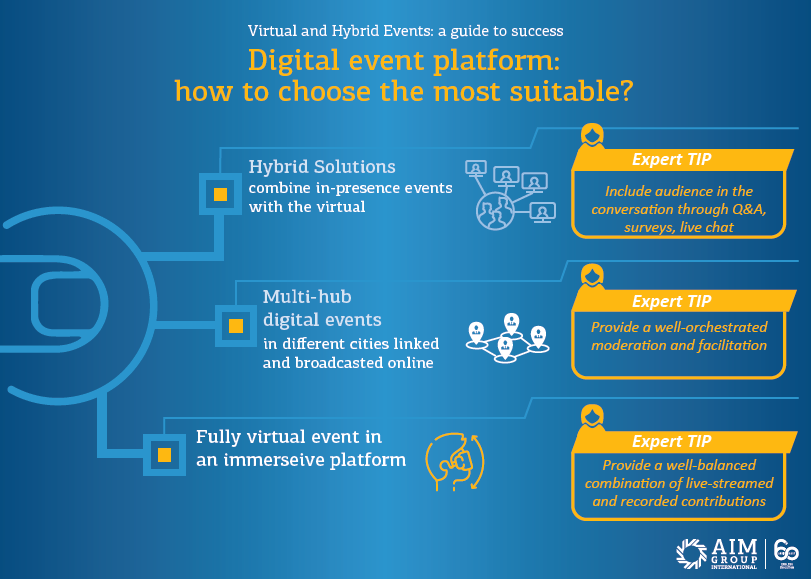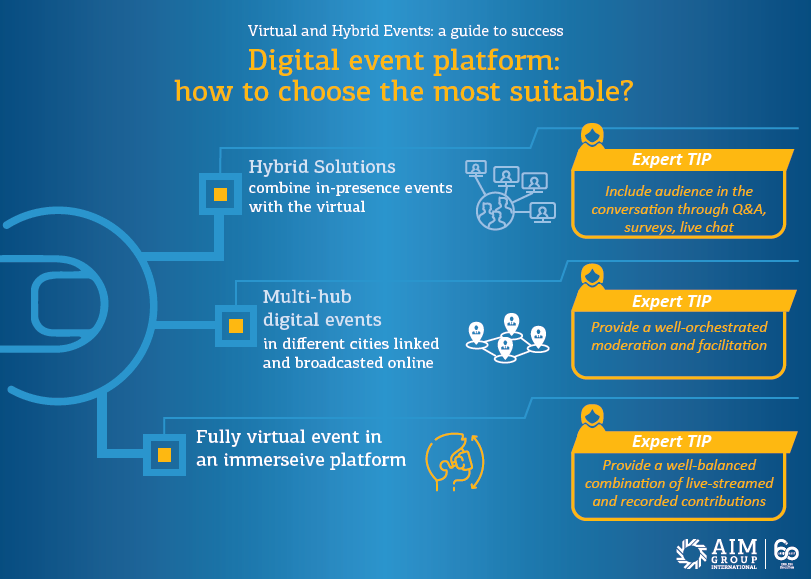
Virtual and Hybrid Events: a guide to success 3/7
Digital platform and the best user experience: how to choose the most suitable solutions? Here the must-have and additional features of a perfect virtual event
To guarantee the best user experience, there are many aspects to consider: aesthetics, ease of use, learning outcomes, the emotional component, time flexibility, networking options and adaptation to different devices etc. The DCO will analyse and recommend which platform and tools fit your event. Any system requires training and familiarization, and our Digital Team is trained for that. When you start planning, a virtual or hybrid event, the first thing that our digital team will need you to consider and evaluate are these three key areas:
- Digital scenarios and formats:
- Hybrid solutions combine in-presence events with the virtual. The schedule and the framework of the live event prevails, though attention should be paid to satisfy remote delegates and speakers and include them in the conversation through Q&A, surveys, live chat etc.
- Multi-hub & digital events involve in-presence events taking place simultaneously in different cities, streamed through a live broadcast and fully accessible online. This format is complex to design. Speakers can be remotely connected and also be in attendance at the various hubs. It is a very interactive format requiring well-orchestrated moderation and facilitation.
- Fully virtual, this format involves a virtual event with a specific schedule, a condensed number of sessions and a well-balanced combination of live-streamed and recorded contributions. This should be designed with the end-user in mind using robust technology and strong professional support.
- Digital production is when a professional production company provides technical services to support the organisation of the meeting or event. It can include: world-class creative and design services, broadcast-quality technology and program creation, project management, streaming and multipoint delivery, virtual exhibits, as well as interactive audience engagement tools, such as website integration, audio/video/text chat, gamification, polls, and video.
- Digital event platform is the setting used to broadcast the content, sessions, and where you can provide on-demand access. There is a big variety of platforms including: fully virtual events with 3D, immersive, realistic layouts which reproduce real locations or artificial set-ups where participants can experience different environments and event sessions. There are endless tools and prices to choose from, off-the shelf or customized/customizable, web and/or mobile based. The event strategist and the digital team will help choose the right one for each event, depending on scope, level of investment and target audience.
Virtual Hybrid Event Features
The features that your hybrid or digital event should have are vast, some are must haves and others are optional.
Must-have features:
- seamless registration process;
- integrated agenda;
- set up for multiple concurrent education sessions with livestream or pre-recorded webinars;
- speaker back-end, self-recording facilities and integrated bios;
- attendee messaging, chat & contact exchange;
- interaction through activity feed, polling & Q&A;
- industry/expo section and sponsorship activities;
- tracking, measurement & analytics.
Nice-to-have additional features:
- 3D visuals and rendering of a real or immersive venue;
- networking opportunities with audience engagement;
- topic-specific meeting rooms and discussion forums;
- virtual tradeshow, booths where exhibitors can meet” face-to-face” and virtually scan leads;
- share slides in real time & get transcripts;
- conversation wall where the community can engage with the streamed webinar or video chat;
- 24/7 live phone support, or email support;
- real-time activity feed;
- element of gamification.

– TO BE CONTINUED –

